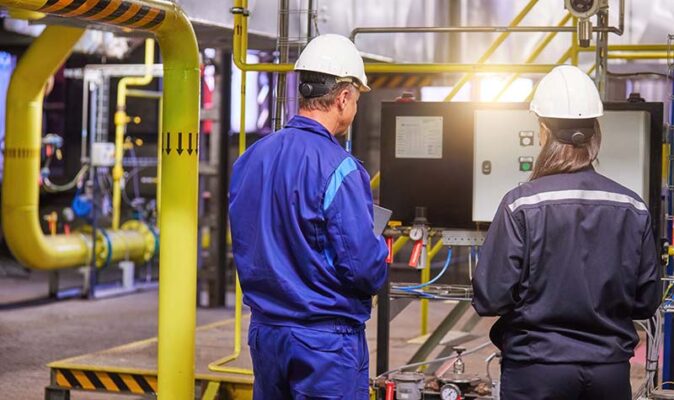5G and IIoT: Emerging Use Cases in Industrial Manufacturing
By Stan Gray
June 5, 2025
By Stan Gray
June 5, 2025
Estimated reading time: 10 minutes

Industrial manufacturers must navigate numerous challenges, from rising costs to supply chain issues. Many seek a holistic approach to digital business transformation. Companies adopt Industry 4.0 technologies to manage complications and remain competitive.
Smart manufacturing focuses on intelligent processes that provide full visibility on the factory floor. The backbone of smart factories is the industrial Internet of Things (IIoT). IIoT connects equipment, sensors and devices to the internet to collect and analyze data in near-real time.
Reliable high-speed connectivity and low latency are essential, especially for critical communications. Yet many factories still rely on industrial Ethernet and Wi-Fi technologies. There is an upward trend to adopt more advanced connectivity solutions like 5G to support Industry 4.0 applications.
As 5G technology continues to evolve, each release builds upon and enhances the capabilities of previous versions. 3GPP Release (Rel) 17 and later include vast improvements in areas like ultrareliable low-latency communication (URLLC). They allow private networks to operate within 5G. They also support shared private networks in a public pool of 5G mobile network operators (MNOs).
Future versions will offer advanced capabilities like artificial intelligence (AI) integration.

Each new 5G version is designed to provide improved connectivity with higher speeds and lower latency. This eliminates cumbersome cabling and enables ultrareliable wireless for critical communications. Newer versions also connect more devices simultaneously.
The ability to make operations more efficient drives industrial manufacturers to consider 5G for smart factories. To achieve this, many companies explore private network options.
Interest in private networks — including those using spectrum in the U.S. — has grown. The more spectrum a company owns inside a wireless network, the faster the speeds and the more customers it can support. Since the initial CBRS auctions, spectrum ownership and private network deployment in the U.S. has become more complex.
Major telecommunications companies now purchase spectrum licenses. On May 28, 2024, United States Cellular (UScellular) sold significant select spectrum assets to T-Mobile. Recently, Verizon purchased spectrum licenses from UScellular to expand its network coverage.
John Deere, an agricultural equipment manufacturer, purchased dedicated spectrum licenses from CBRS. The company has two rural 5G-connected factories and uses 5G to maximize efficiency in its facilities.
The German government grants licenses to factories for spectrum ranges. High-profile German companies, such as Bosch and Siemens, acquired spectrum to implement 5G at their facilities.
While enhanced mobile broadband (eMBB) is one of the primary use cases for early 5G deployments, it’s not the only focus. Rel 17 and later include significant improvements in URLLC and support for massive IoT deployments. In addition, there is better support for industrial applications with edge computing and network slicing.

Two methods exist to set up a private 5G network. One is to establish a network separate from the public 5G network of MNOs. The second method is network slicing.
Multiple virtual private networks (or slices) utilize publicly shared MNO resources. In this case, the MNOs build a dedicated, private 5G network for the enterprise and use shared resources from the public network. This was not possible before 5G.
Network slicing allocates specific network resources to each slice, including bandwidth. Resources are assigned from less-important slices to critical situations in one 5G network.
The latest 5G release enhances network slicing with more advanced features and greater flexibility in managing slices. With network slicing, thousands of connected devices that perform various functions can be tracked.
Slicing can manage multiple IoT applications in complex workspaces. One slice can monitor temperature and energy sensors for facility managers. At the same time, another slice supports drone control and self-driving vehicle updates for technicians. Companies can maximize their return on investment (ROI) by efficiently using and managing network resources at scale.

5G’s enhanced connectivity supports critical IIoT applications, such as:
As each new release unfolds, new use cases follow. Here are five use cases in industrial manufacturing impacted by 5G.
Factories depend on repetitive tasks historically conducted by humans. Industrial automation increases efficiency by replacing humans with advanced technologies.
Solutions, such as control systems and IIoT devices, manage these tasks. They leverage technologies like IoT sensors and autonomous mobile robots. These automated solutions are part of broader smart systems. They streamline production processes and enhance overall efficiency.
5G enhances automation and networking capabilities. The latest 5G release offers vast improvements in low-latency wireless communications. This enables real-time machine monitoring and control.

Edge intelligence refers to processing and analyzing data locally at the source. Limited wireless communication can make implementing edge intelligence in industrial environments a challenge. While many field devices don’t need ultralow latency, managing their vast data on-site is difficult without enough bandwidth.
On the other hand, 5G offers the bandwidth and speed necessary to support edge AI in industrial settings. With 5G and IIoT, manufacturing sites can manage thousands of connected devices. They can also perform real-time data analytics at the edge. As a result, manufacturers experience more efficient operations and faster decision-making.
One use case involves edge AI-enabled surveillance cameras in factories. These smart cameras use AI to detect unusual events. They identify incidents — such as accidents or security breaches — without constant video streaming of employees. 5G connectivity maintains privacy and enhances security.
An unusual occurrence, like a worker falling, prompts the camera to send an alert over 5G for human intervention. The camera only transmits data when necessary rather than constantly monitoring. This approach allows for rapid responses to emergencies while complying with privacy regulations.
5G technology enhances supply chain management, optimizing operations with real-time tracking of goods’ locations. 5G track-and-trace technologies reduce delays in the supply chain through precise coordination.
For example, an automotive factory can monitor the shipment status of incoming parts through 5G. The tracking data is integrated into the workflow. Production lines are then configured to optimize manufacturing based on real-time component arrival information.
In addition, 5G’s low latency enables vehicle-to-vehicle communication in real time. Supply chains can rely on autonomous trucks and robots with more precision. As a result, companies can streamline logistics operations to reduce delays and improve delivery times.

Organizations use predictive maintenance data to plan current and future maintenance. Correctly functioning equipment is crucial for factories and industrial sites.
IIoT sensors monitor machine health and send alerts for problems or upcoming maintenance. With 5G, these sensors give plant managers real-time information about equipment performance and productivity.
5G enables wireless connectivity, which decreases the need for physical cables in factories and industrial sites. Control systems communicate with machines and sensors through 5G networks without extensive wiring. This wireless approach eliminates potential cable or wear defects, reducing downtime and maintenance costs.
Manufacturers no longer need to spend time and money to reroute or replace cables when rearranging production lines. An automotive assembly line that uses 5G adapts to new product variations without the constraints of fixed cabling. This minimizes tripping hazards and simplifies floor layouts, contributing to a safer, more adaptable environment.

The latest 5G devices drive and enable Industry 4.0 applications on factory floors. In the past, machine-to-machine communication in industrial settings was complicated. Proprietary software and hardware from various vendors made IIoT implementation on factory floors difficult.
Industry leaders developed the Open Platform Communications Unified Architecture (OPC UA) protocol to streamline connections. It’s implemented over a time-sensitive network (TSN). A TSN provides networking capabilities needed for real-time industrial applications.
5G works with OPC UA over TSN to enable integrated, low-latency networking for increased reliability and control. It offers the bandwidth and speed necessary to support edge AI and improve real-time decisions on the factory floor.
Alif Semiconductor microcontrollers (MCUs) support advanced analytics and AI applications. Alif partnered with Telit Cinterion to deliver advanced wireless connectivity to evaluate AI and machine learning.
Alif’s Ensemble family of MCUs integrates AI acceleration hardware alongside traditional CPU cores. This enables efficient on-device AI processing, which is essential for real-time quality control and predictive maintenance tasks. Its power-efficient operation supports battery-powered and energy-sensitive applications in industrial settings.
Fraunhofer IPT and Ericsson researched ways to use 5G in production to detect high-precision manufacturing failures of bladed disks (BLISKs). Aircraft jet engines use these critical multi-bladed rotor disks. Vibration and “chatter” during milling are common problems.
Quality throughout production is essential to guarantee the safety of BLISKs. However, the process is challenging to monitor. The milling process can take hundreds of hours. Rework is often as high as 25%.
5G provides ultralow latency. The sensor’s data is processed and acted upon for close to 1 millisecond. It also enables vibration sensor monitoring.
Immediate adjustments can be made to the production process in real time. This capability improves BLISK manufacturing quality and efficiency. Ericsson estimated a potential savings of over $29 million for a single factory.

While 5G promises significant gains for every industry, some hurdles exist.
In the past, ultrareliable low latency needed for precision use cases was not possible with Wi-Fi. The latency ranged between 11 ms and 25 ms, and the distance from the access point could make latency worse.
It affected critical manufacturing processes and precision applications, including:
Latency can be 30 ms to 70 ms with 4G.
The latest 5G standards improve ultralow latency with real-time processing. They have enabled use cases and applications that were not possible in 4G. 5G delivers ultrareliable low latency of 1 ms or less.
The 5G network architecture and technologies are complex. They involve:
This can make deployment and management complicated without the right resources and partners.
Advancements bring issues like security vulnerabilities and privacy. As new risks emerge, security must be part of the manufacturing process. The latest release of 5G supports enhanced cybersecurity to protect your critical infrastructure. Future releases of 5G will add even more support for changing manufacturing environments.
Choose a proven global communication partner to address your cybersecurity concerns and protect sensitive manufacturing data and processes.
Telit Cinterion stands out as an IoT and 5G leader. Our innovative solutions demonstrate our commitment to Industry 4.0 and 5G technologies. We stay on top of the latest industrial manufacturing standards and advancements.
Our comprehensive approach includes cellular 5G modules and deviceWISE® AI, powered by Telit Cinterion, for industrial IoT with AI and machine learning. We are committed to security and well-positioned to drive the future of connected technologies in major industries.
Speak with our experts to get started on your 5G IIoT application.
Editor’s note: This blog was originally published on 13 January 2021 and has since been updated.